Unit 3 What's your favourite sport 教案-公开课-优质课(外研版七上精品)
- 格式:doc
- 大小:32.00 KB
- 文档页数:3

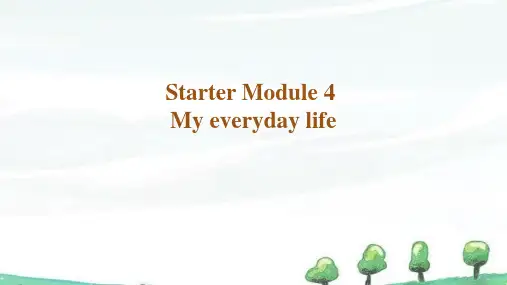
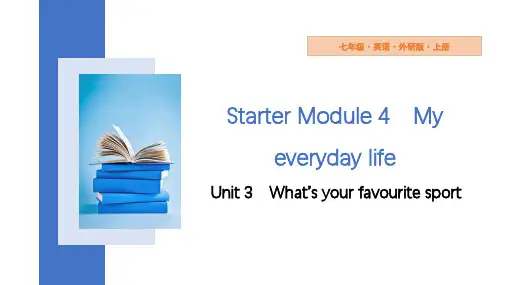
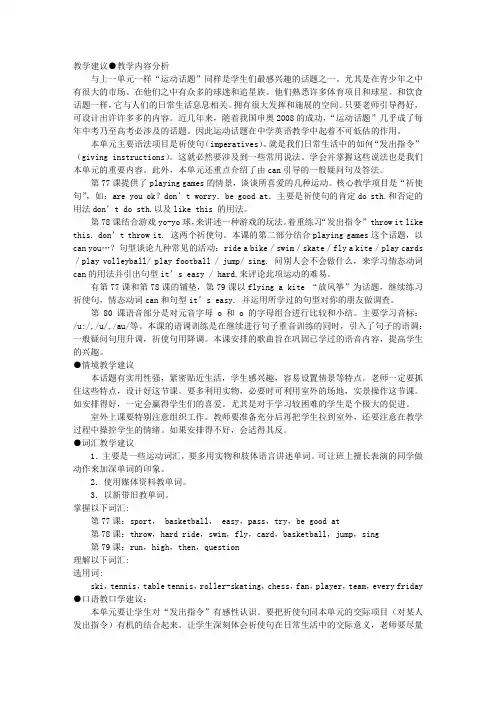
教学建议●教学内容分析与上一单元一样“运动话题”同样是学生们最感兴趣的话题之一。
尤其是在青少年之中有很大的市场。
在他们之中有众多的球迷和追星族。
他们熟悉许多体育项目和球星。
和饮食话题一样,它与人们的日常生活息息相关。
拥有很大发挥和施展的空间。
只要老师引导得好,可设计出许许多多的内容。
近几年来,随着我国申奥2008的成功,“运动话题”几乎成了每年中考乃至高考必涉及的话题。
因此运动话题在中学英语教学中起着不可低估的作用。
本单元主要语法项目是祈使句(imperatives)。
就是我们日常生活中的如何“发出指令”(giving instructions)。
这就必然要涉及到一些常用说法。
学会并掌握这些说法也是我们本单元的重要内容。
此外,本单元还重点介绍了由can引导的一般疑问句及答法。
第77课提供了playing games的情景,谈谈所喜爱的几种运动。
核心教学项目是“祈使句”,如:are you ok?don’t worry.be good at.主要是祈使句的肯定do sth.和否定的用法don’t do sth.以及like this 的用法。
第78课结合游戏yo-yo球,来讲述一种游戏的玩法。
着重练习“发出指令” throw it like this. don’t throw it. 这两个祈使句。
本课的第二部分结合playing games这个话题,以can you…?句型谈论九种常见的活动:ride a bike/swim/skate/fly a kite/play cards /play volleyball/ play football / jump/ sing. 问别人会不会做什么,来学习情态动词can的用法并引出句型it’s easy / hard.来评论此项运动的难易。
有第77课和第78课的铺垫,第79课以flying a kite “放风筝”为话题,继续练习祈使句,情态动词can和句型it’s easy. 并运用所学过的句型对你的朋友做调查。
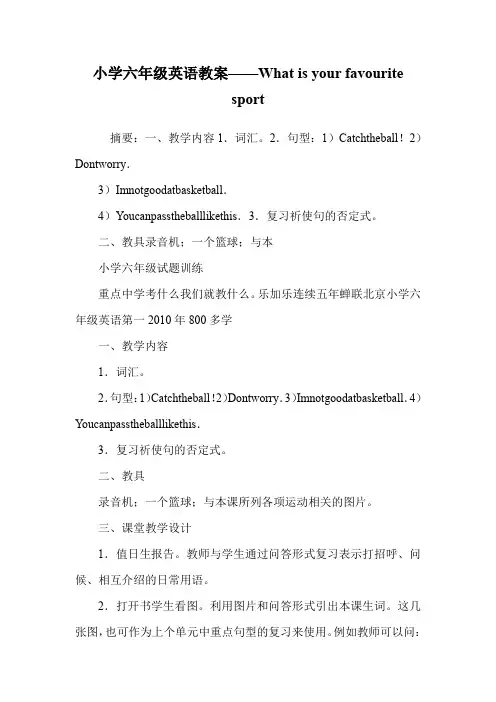
小学六年级英语教案——What is your favouritesport摘要:一、教学内容1.词汇。
2.句型:1)Catchtheball!2)Dontworry.3)Imnotgoodatbasketball.4)Youcanpasstheballlikethis.3.复习祈使句的否定式。
二、教具录音机;一个篮球;与本小学六年级试题训练重点中学考什么我们就教什么。
乐加乐连续五年蝉联北京小学六年级英语第一2010年800多学一、教学内容1.词汇。
2.句型:1)Catchtheball!2)Dontworry.3)Imnotgoodatbasketball.4)Youcanpasstheballlikethis.3.复习祈使句的否定式。
二、教具录音机;一个篮球;与本课所列各项运动相关的图片。
三、课堂教学设计1.值日生报告。
教师与学生通过问答形式复习表示打招呼、问候、相互介绍的日常用语。
2.打开书学生看图。
利用图片和问答形式引出本课生词。
这几张图,也可作为上个单元中重点句型的复习来使用。
例如教师可以问:T:Whatcanyouseeinthepicture?Howmanyboys/treescanyouseeinthepicture?或:Howmanycarscanyouseeinthepicture?3.教师利用手中篮球,请一个男同学到前面来,通过传、接球演示,引出以下对话:T:Comeon,!Catchtheball!传递一、两个来回后,教师故意没有接住:T:Ouch!启发学生说出:S:Sorry!Mr.AreyouOK?T:Yes,Imfine.Dontworry.4.再请一位不大会打篮球的女同学到前面来。
这位女同学会面露难色。
启发她说出:S:Imsorry.Imnotgoodatbasketball.教师提问:T:Thenwhatsyourfavouritesport?S:Ilikeswimming/ping-pong/volleyball5.放课文第1部分录音,学生跟读数遍,分小组练习。
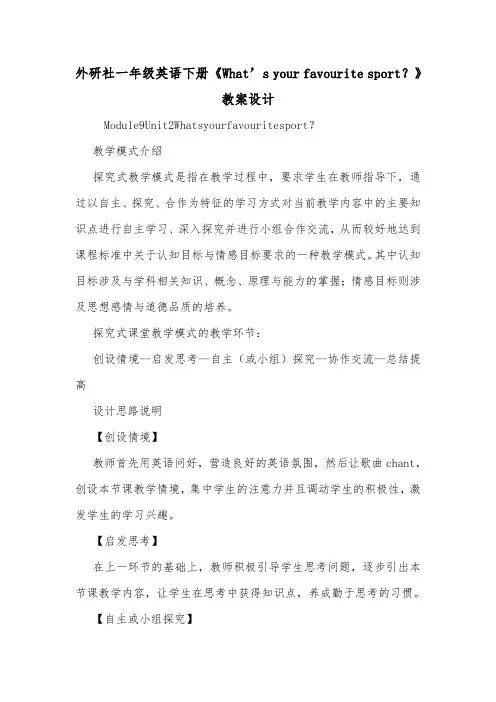
外研社一年级英语下册《What’s your favourite sport?》教案设计Module9Unit2Whatsyourfavouritesport?教学模式介绍探究式教学模式是指在教学过程中,要求学生在教师指导下,通过以自主、探究、合作为特征的学习方式对当前教学内容中的主要知识点进行自主学习、深入探究并进行小组合作交流,从而较好地达到课程标准中关于认知目标与情感目标要求的一种教学模式。
其中认知目标涉及与学科相关知识、概念、原理与能力的掌握;情感目标则涉及思想感情与道德品质的培养。
探究式课堂教学模式的教学环节:创设情境--启发思考--自主(或小组)探究--协作交流--总结提高设计思路说明【创设情境】教师首先用英语问好,营造良好的英语氛围,然后让歌曲chant,创设本节课教学情境,集中学生的注意力并且调动学生的积极性,激发学生的学习兴趣。
【启发思考】在上一环节的基础上,教师积极引导学生思考问题,逐步引出本节课教学内容,让学生在思考中获得知识点,养成勤于思考的习惯。
【自主或小组探究】自主探究环节教师展示教材教学图片,让学生思考提问的问题,培养学生独立思考的能力。
合作探究环节的对话练习活动让加强小组合作的意识,以达成巩固和熟练运用单词和句型的能力。
【协作交流】教师先让学生协作共同完成教材活动六的内容,让学生养成积极协作的好习惯,然后播放的歌曲,让学生感受歌曲的欢快的韵律同时让学生巩固本节课的知识点。
教师让学生积极上台表演,锻炼学生积极上台展现自己的勇气。
【总结提高】通过对于本节课内容的思考、探究和迁移,学生逐步掌握本节课知识点,教师带领学生将本课的知识框架进行回顾和总结,让学生学以致用,最后结合本课知识点让学生培养热爱体育,积极锻炼身体的好习惯。
教材分析本课继续爱好这一主题,导入whatsyourfavourite...这一询问最喜爱的事物的疑问句型,同时将范围从上课的运动扩大到其他领域如颜色和动物。
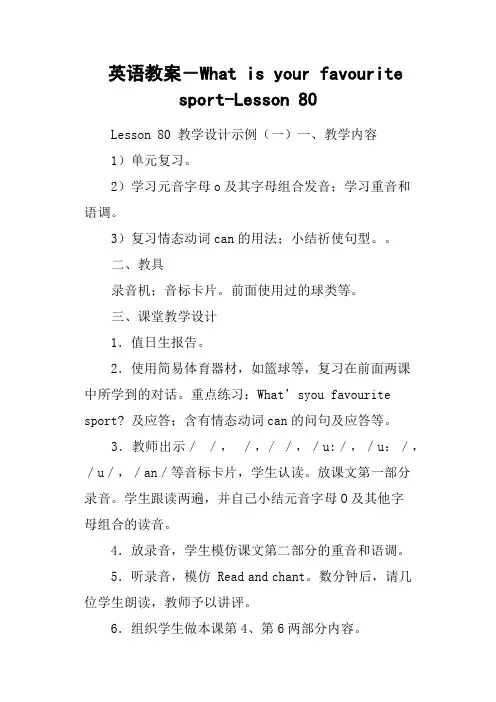
英语教案-What is your favouritesport-Lesson 80Lesson 80 教学设计示例(一)一、教学内容1)单元复习。
2)学习元音字母o及其字母组合发音;学习重音和语调。
3)复习情态动词can的用法;小结祈使句型。
二、教具录音机;音标卡片。
前面使用过的球类等。
三、课堂教学设计1.值日生报告。
2.使用简易体育器材,如篮球等,复习在前面两课中所学到的对话。
重点练习:What’syou favourite sport? 及应答;含有情态动词can的问句及应答等。
3.教师出示//,/,/ /,/u:/,/u:/,/u/,/an/等音标卡片,学生认读。
放课文第一部分录音。
学生跟读两遍,并自己小结元音字母O及其他字母组合的读音。
4.放录音,学生模仿课文第二部分的重音和语调。
5.听录音,模仿 Read and chant。
数分钟后,请几位学生朗读,教师予以讲评。
6.组织学生做本课第4、第6两部分内容。
7.听力训练。
放录音之前,可给学生一分钟时间看第92、93页上有关题目。
放录音两至三遍,学生绘出答案,教师订正。
8.如时间允许,学唱Let Your Kite Fly High。
9.学生阅读复习要点(20),教师解答学生问题。
10.布置作业完成练习册习题。
11.小测验1)听写本单元中重点词语和主要句型。
2)94页汉译英。
Lesson 80 教学设计示例(二)● 教学目标1.复习语音语调。
2。
复习句型What’s your favourite…? My favourite …is…。
用法。
3.学会填写表格,如:健康表,游泳证等。
● 教学用具录音机、投影仪、图片、游泳证或健康卡片等。
● 教学步骤Step 1 Revision听录音完成第一、二、三部分。
第三部分容易引起学生的兴趣,可组织个人模仿、小组模仿、集体模仿等多种形式。
Step 2 Presentation会填写表格。
Children’s Swimming ClubName ______________Age_____ Sex _____ School _______Student No。
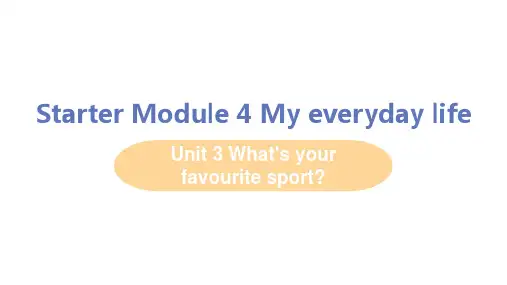
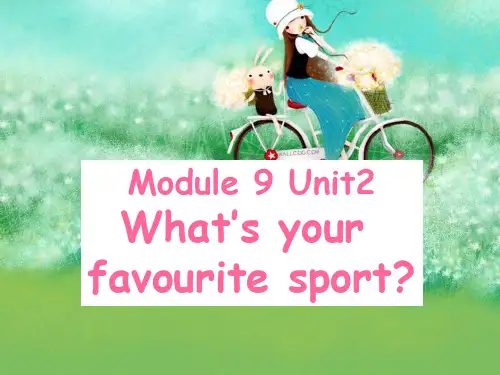
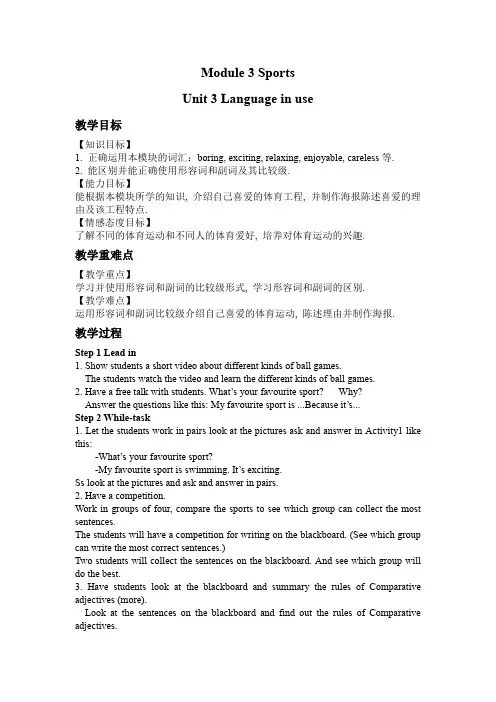
Module 3 SportsUnit 3 Language in use教学目标【知识目标】1. 正确运用本模块的词汇:boring, exciting, relaxing, enjoyable, careless等.2. 能区别并能正确使用形容词和副词及其比较级.【能力目标】能根据本模块所学的知识, 介绍自己喜爱的体育工程, 并制作海报陈述喜爱的理由及该工程特点.【情感态度目标】了解不同的体育运动和不同人的体育爱好, 培养对体育运动的兴趣.教学重难点【教学重点】学习并使用形容词和副词的比较级形式, 学习形容词和副词的区别.【教学难点】运用形容词和副词比较级介绍自己喜爱的体育运动, 陈述理由并制作海报.教学过程Step 1 Lead in1. Show students a short video about different kinds of ball games.The students watch the video and learn the different kinds of ball games.2. Have a free talk with students. What’s your favourite sport? Why?Answer the questions like this: My favourite sport is ...Because it’s...Step 2 While-task1. Let the students work in pairs look at the pictures ask and answer in Activity1 like this:-What’s your favourite sport?-My favourite sport is swimming. It’s exciting.Ss look at the pictures and ask and answer in pairs.2. Have a competition.Work in groups of four, compare the sports to see which group can collect the most sentences.The students will have a competition for writing on the blackboard. (See which group can write the most correct sentences.)Two students will collect the sentences on the blackboard. And see which group will do the best.3. Have students look at the blackboard and summary the rules of Comparative adjectives (more).Look at the sentences on the blackboard and find out the rules of Comparative adjectives.4. Show students two sentences and ask them to find out the usage between adjectivesand adverbs.5. Have students make sentences with adjectives and adverbs.Step 3 Post-task1. Have students work in groups and complete the sentences and passage with thewords in the brackets of Activity 2-4.2. Call back the answers.3. Ask the students to work in groups talk about their favourite Olympic sports andmake a sports poster.Work in groups talk about their favourite Olympic sports and make a sports poster.A: What’s your favourite Olympic sport?B: My favourite Olympic sport is...A: Why do you like it?B: I like it because...Step 4 SummaryAsk the students to conclude the usage of adjectives and adverbs and their comparative.课堂作业Write an email to your best friend about your favourite sport.教学反思Module 5 Lao She Teahouse一、教学内容:Unit 3 Language in use二、课型:Revision and application三、教学目标:1. 正确运用本模块的词汇及短语2、掌握动词不定式作宾语的用法. 并能通过小组合作, 把一部戏剧中的一幕改编成短剧并在班上表演.四、教学重难点:掌握动词不定式作宾语的用法. 并能通过小组合作, 把一部戏剧中的一幕改编成短剧并在班上表演.五、教学准备:本节课型为Revision and application, 根据新课标的要求, 结合教材和学生特点, 主要采用任务型互动式进行教学, 结合情景法、交际法、听说法、归纳法等教学方法实施课堂活动, 开启学生思维, 通过一系列有条理的教学活动, 引导学生自主探究学习和与他人互动合作学习, 让学生体验愉快学习. 本节课所需教具及资料:幻灯、图片、调查表等.六、教学过程:达标训练题一、单项选择.〔〕1. Let’s _________ for a walk, shall we?- ____________,A. to goB. goingC. goD. gone( ) 2. The boss made the workers ________ the job on time.A. finish finished C. finishes D. to finish( ) 3. It’s necessary for us __________ Mont Yuntai.A. go climbingB. go to climbC. to go climbingD. goes climbing( ) 4. - Mary, What’s that? - A card. Linda ______ it _______me yesterday.A. sent ; forB. sent ; toC. gives ; forD. gives; to( ) 5. I decide ________ a translator in the future.A. beB. to beC. beingD. am二、阅读理解Most people make their living〔谋生〕with their hands, but Bob makes his living with his feet.Bob’s story began in a small city in England. His parents were poor. Seven people lived in a small house. Bob had no place to play but on the street.Bob’s father often played football. Little Bob wanted to play football, too. So his father made a soft 〔柔软的〕ball for him to kick. It was a sock full of old cloth. He kicked it every day.At last , Bob learned to kick a real football. And after a few years he could play football very well.根据短文内容, 选择最正确答案.( ) 1.People usually make their living ______________.A. by learning by themselvesB. with their feetC. by playing footballD. with their hands( ) 2. Which of the following is TRUE?A. Bob was born in a small village.B. Bob’s house was very big.C. There were eight people in the family.D. The little boy often played on the street.( ) 3. Why did the father make a soft ball for his son ?A. Because the family all liked footballB. Because Bob also liked to play football.C. Because they had a lot of old cloth.D. Because he didn’t want to throw the sock away.( ) 4. The word “ kick〞in the story means ________.A. 踢B. 玩C. 射门D.弹起( ) 5. From the story we can see _________________.A. Bob’s ageB. it’s about an American boyC. Bob’s mother’s nameD. the boy became a good football player at last.。
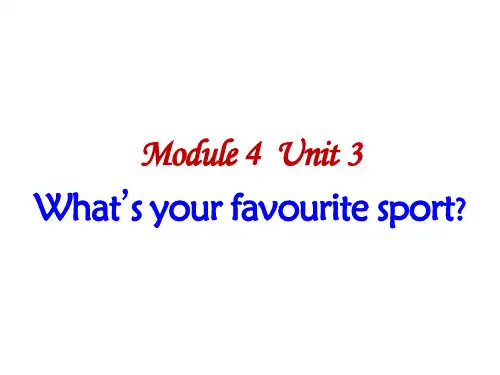
Starter Module 4 Unit 3教案Step 1 Lead in:1. Review the text of Unit 1 and2.2. Show some pictures, ask the students to look at the pictures, then talk something about the pictures.3. Introduce the new words.1. basketball2. football3. swimming4. table tennisStep 2 V ocabulary study:1. Show some pictures by PPT.2. Ask and answer:What’s your favourite sport?3. Learn the new words.4. Read the new words.Step 3 Listen and number.1. Ask the students to look at the pictures in Activity2.2. Read the words in Activity 1.3. Play the recording and ask the students to listen and number.4. Call back the answer from the whole class and check the answer.Step 4 Listen and read.1. Ask the students to look at the pictures in Activity 3.2. Talk something about the pictures.3. Play the recording and ask the students to listen.4. Ask the students to read the conversation silently.5. Play the recording and ask the students to listen and read the conversation.6. Read the conversation together.Tony: What’s your favourite sport, Daming?Daming: Football!Tony: It’s my favourite sport too!Daming: Let’s play football after school.Tony: OK. Good idea!Betty: What’s your favourite sport, Lingling?Lingling: Swimming.Betty: I like swimming too.Ling ling: Let’s go swimming on Wednesday.Betty: OK.7. Act it out.Step 5 Read and number.1. Ask the students to read the sentences in Activity 4.2. Read and number.a) What’s your favourite sport? □b) Let’s play basketball after school. □c) OK. Good idea! □d) Basketball! □e) I like basketball, too. □3. Call back the answer from the whole class and check the answer.4. Listen again and check.Step 6 Write.1. Read the words in Activity 5.basketball football swimming table tennis2. Complete the table.3. Call back the answer from the whole class and check the answer. Step 7 Work in pairs.1. Ask and answer like this.—What’s your favourite sport?—…—Let’s … this afternoon.—OK...2. Work in pairs.Step 8 Listen and write.1. Play the recording and ask the students to listen.2. Fill in the blank.A: What’s ___________________ sport?B: I like ______________.A: Let’s ____________.B: OK.____________.3. Now listen again and check.。
Unit 3 What`s your favourite sport评课稿Unit 3 What`s your favourite sport?评课稿课题:7A Unit 3 What`s your favourite sport?时间: 2015年10月21日评课人:xx听了xx老师所上的一节7A Unit 3 What`s your favourite sport?的第一课时后,感触颇深,他是一位新教师,但在课堂教学上确实独具一格,下面就谈谈我的感受:一、新课导入是提高课堂教学有效性的基础。
俗话说:良好的开端是成功的一半。
一节课课题的导入与该课的教学效果有着密切的联系。
在教学中,新课的导入是很重要的一个环节,本堂课范老师利用了1.视频导入法。
七年级学生活泼好动,且善于接受新事物。
因此,为了激发学生对英语课堂内容的兴趣和拓展课堂信息的容量,老师利用了视频具有集图形、声音、动作为一体的特点,并且这种导入方式激起了学生了解这座城市的强烈兴趣,吸引了他们的注意力。
紧跟着再提出相关的思考问题,为接下来的教学做了很好的铺垫。
2. 巧用图片法把英语单词同实物或情景直接联系,增强语言的真实性、形象感,易于调动和保持学生的学习兴趣。
特别是对于英语学习初级阶段的学生,采用直观教学,使学生一开始就把实物与英语直接联系起来,获得一个直观印象。
加强了词汇和语法知识点呈现的直观性。
二、学习单与强化巩固的完美结合是提高课堂教学有效性的核心与关键。
“这堂课最大的亮点就是利用学习单围绕教学主题,在多样化的活动中学和练,学中有练,练中有学,新授与巩固融为一体。
在教授新知识的过程中巩固,在强化巩固的过程中授新。
这节课是一节听说课,范老师的这堂课活动形式多样化,活动层次梯度化,采用了多样化的方法。
如小组讨论,角色扮演、模仿、游戏、竞赛等方法。
并且整堂的参与不只是一种形式,他让所有的学生都充分的加入到活动当中去,强调语言的交际功能,这堂课处处彰显出了英语教学的有效性。
Module 4 My everyday life Unit 3 What’s your favorite sportTeaching analysis Teachingaims1. Function: Recognition of colors.2. Listening: Students can understand others’ questions ofasking colors, and give corresponding answers.3. Speaking: Students can ask and answer colors.4. Reading: Students can understand the similar dialogue ofasking and answering colors.5. Writing:Students can write colors.Teachingimportantanddifficultpoints1. Master language of asking color of things, and master theEnglish expressions of colors.2. Key vocabulary and phrases: black, white, blue, green,yellow, red, brown, orange, color, and What color is/are …?3. Be skilled in oral expression of asking and answering thecolors of things.Teaching type Reading and writingTeachingmeasurePwp Teaching tools Tape recorder, PPTTeaching proceduresChapter 1 Lead-in : Warming upStep 1 Lead-in1. Review the text of Unit 1 and2.2. Show some pictures, ask the students to look at the pictures, then talk something about the pictures.3. Introduce the new words.1basketball 2football 3swimming 4table tennisChapter 2 The students can learn by themselves, and ask some questions about the study.Step 2 Vocabulary study1. Show some pictures by PPT.2. Ask and answer:What’s your favorite sport?3. Learn the new words.4. Read the new words.Step 3 Listen and number1. Ask the students to look at the pictures in Activity2.2. Read the words in Activity 1.3. Play the recording and ask the students to listen and number.4. Call back the answer from the whole class and check the answer.Keys: b d a cChapter 3 The students can learn the main point with the help of the teacher, and solve the problems.Step 4 Listen and read1. Ask the students to look at the pictures in Activity 3.2. Talk something about the pictures.3. Play the recording and ask the students to listen.4. Ask the students to read the conversation silently.5. Play the recording and ask the students to listen and read the conversation.6. Read the conversation together.Tony: What’s your favorite sport, Daming? Daming: Football!Tony: It’s my favorite sport too!Daming: Let’s play football after school.Tony: OK. Good idea!Betty: What’s your favorite sport, Lingling?Lingling: Swimming.Betty: I like swimming too.Lingling: Let’s go swimming on Wednesday.Betty: OK.7. Act it out.Chapter 4 Effective practice, consolidate the knowledgeStep 5 Read and number1. Ask the students to read the sentences in Activity 4.2. Read and number.a) W hat’s your favorite sport? □b) Let’s play basketball after school. □c) OK. Good idea!d) Basketball!e) I like basketball, too.Keys: a1 b4 c5 d2 e33. Call back the answer from the whole class and check the answer.4. Listen again and check.Step 6 Writing1. Read the words in Activity 5.basketball football swimming table tennis2. Complete the table.go playswimming basketball3. Call back the answer from the whole class and check the answer.Keys: go swimming play basketball play football play table tennis Step 7 Work in pairs1. Ask and answer like this.—What’s your favorite sport?—…—Let’s … this afternoon.—OK...2. Work in pairs.Step 8 Listen and write.1. Play the recording and ask the students to listen.2. Fill in the blank.A: What’s ___________________ sport?B: I like ______________.A: Let’s ____________.B:. OK.____________.3. Now listen again and check.Keys: your favorite swimmin g go swimming Let’s goChapter 5 Summary evaluation, leak turnoverMaster language of asking color of things, and master the English expressions of colors.Key vocabulary and phrases: black, white, blue, green, yellow, red, brown, orange, color, and What color is/are …?Be skilled in oral expression of asking and answering the colors of things.。
What’s your favourite sport学习目标:实际用时:1、掌握体育运动的单词。
basketball football swimming table tennis2、会读、会写、会用本单元出现的新单词3、规范单词和句子的书写.学习重难点:1、能使用英语询问“最喜欢什么运动”,并能回答 .2、词汇:basketball football swimming table tennis3、句型:1.--- What’s you r favourite sport? ----I like doing sth.2. Let’s go swimming .☆课前预习☆一、预习P89单词表,根据所给中文意思写出英语单词,并学着读。
1. 篮球_________2. 足球_________3. 游泳_________4.乒乓球_________5. 运动_________6. 让,使_________7.(宾格)我们_________8. 参加_________ 9. 在......后_________ 10.学校_________ 11. 想法_________2. 在课本上写出以上单词的音标。
二. 短语互译:1. 放学后____________2.踢足球___________3. 在星期三___________4. go swimming___________5. my favourite sport_____________三、读一读熟读以下句型:1. What’s your favorite sports?2. It’s my favorite sport too.3. ---Let’s play football after school. --- OK. Good idea!4. I like swimming too. Let’s go swimming on Wednesday.5. I like basketball too.☆ 课文导读☆1. Let’s play football after school. 咱们放学后去踢足球吧。
What is your favourite sport (三) Lesson 80 教学设计示例(一)一、教学内容1)单元复习。
2)学习元音字母o及其字母组合发音;学习重音和语调。
3)复习情态动词can的用法;小结祈使句型。
二、教具录音机;音标卡片。
前面使用过的球类等。
三、课堂教学设计1.值日生报告。
2.使用简易体育器材,如篮球等,复习在前面两课中所学到的对话。
重点练习:What’syou favourite sport? 及应答;含有情态动词can的问句及应答等。
3.教师出示//,/,/ /,/u:/,/u:/,/u/,/an/等音标卡片,学生认读。
放课文第一部分录音。
学生跟读两遍,并自己小结元音字母O及其他字母组合的读音。
4.放录音,学生模仿课文第二部分的重音和语调。
5.听录音,模仿 Read and chant。
数分钟后,请几位学生朗读,教师予以讲评。
6.组织学生做本课第4、第6两部分内容。
7.听力训练。
放录音之前,可给学生一分钟时间看第92、93页上有关题目。
放录音两至三遍,学生绘出答案,教师订正。
8.如时间允许,学唱Let Your Kite Fly High。
9.学生阅读复习要点(20),教师解答学生问题。
10.布置作业完成练习册习题。
11.小测验1)听写本单元中重点词语和主要句型。
2)94页汉译英。
Lesson 80 教学设计示例(一)一、教学内容1)单元复习。
2)学习元音字母o及其字母组合发音;学习重音和语调。
3)复习情态动词can的用法;小结祈使句型。
二、教具录音机;音标卡片。
前面使用过的球类等。
三、课堂教学设计1.值日生报告。
2.使用简易体育器材,如篮球等,复习在前面两课中所学到的对话。
重点练习:What’syou favourite sport? 及应答;含有情态动词can的问句及应答等。
3.教师出示//,/,/ /,/u:/,/u:/,/u/,/an/等音标卡片,学生认读。
Starter Module 4 Unit 3教案
Step 1 Lead in:
1. Review the text of Unit 1 and
2.
2. Show some pictures, ask the students to look at the pictures, then talk something about the pictures.
3. Introduce the new words.
1. basketball
2. football
3. swimming
4. table tennis
Step 2 V ocabulary study:
1. Show some pictures by PPT.
2. Ask and answer:
What’s your favourite sport?
3. Learn the new words.
4. Read the new words.
Step 3 Listen and number.
1. Ask the students to look at the pictures in Activity
2.
2. Read the words in Activity 1.
3. Play the recording and ask the students to listen and number.
4. Call back the answer from the whole class and check the answer.
Step 4 Listen and read.
1. Ask the students to look at the pictures in Activity 3.
2. Talk something about the pictures.
3. Play the recording and ask the students to listen.
4. Ask the students to read the conversation silently.
5. Play the recording and ask the students to listen and read the conversation.
6. Read the conversation together.
Tony: What’s your favourite sport, Daming?
Daming: Football!
Tony: It’s my favourite sport too!
Daming: Let’s play football after school.
Tony: OK. Good idea!
Betty: What’s your favourite sport, Lingling?
Lingling: Swimming.
Betty: I like swimming too.
Ling ling: Let’s go swimming on Wednesday.
Betty: OK.
7. Act it out.
Step 5 Read and number.
1. Ask the students to read the sentences in Activity 4.
2. Read and number.
a) What’s your favourite sport? □
b) Let’s play basketball after school. □
c) OK. Good idea! □
d) Basketball! □
e) I like basketball, too. □
3. Call back the answer from the whole class and check the answer.
4. Listen again and check.
Step 6 Write.
1. Read the words in Activity 5.
basketball football swimming table tennis
2. Complete the table.
3. Call back the answer from the whole class and check the answer. Step 7 Work in pairs.
1. Ask and answer like this.
—What’s your favourite sport?
—…
—Let’s … this afternoon.
—OK...
2. Work in pairs.
Step 8 Listen and write.
1. Play the recording and ask the students to listen.
2. Fill in the blank.
A: What’s ___________________ sport?
B: I like ______________.
A: Let’s ____________.
B: OK.____________.
3. Now listen again and check.。